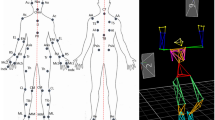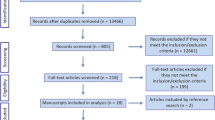Abstract
The objective was to investigate if healthy elderly people respond and adapt differently to postural disturbances compared to middle-aged people. Thirty middle-aged (mean age 37.8 years, range 24–56 years) and forty healthy elderly subjects (mean age 74.6 years, range 66–88 years) were tested with posturography. Body sway was evoked by applying pseudorandom vibratory stimulation to the belly of the gastrocnemius muscles of both legs simultaneously. The tests were performed both with eyes open and eyes closed. The anteroposterior body sway was measured with a force platform and analyzed with a method that considers the adaptive changes of posture and stimulation responses. The results showed that middle-aged people generally used a different postural control strategy as compared to the elderly. The elderly responded more rapidly to vibratory perturbation, used more high-frequency (>0.1 Hz) motions and the motion dynamics had a higher degree of complexity. Moreover, the elderly had diminished ability to use visual information to improve balance control. Altogether, despite having an effective postural control adaptation similar to that of middle-aged people, the elderly had more difficultly in withstanding balance perturbations. These findings suggest that the balance control deterioration associated with aging cannot be fully compensated for by postural control adaptation.





Similar content being viewed by others
References
Altman D (1991) Practical statistics for medical research. Chapman and Hall, New York
Baloh R, Jacobson K, Socotch T (1993) The effect of aging on visual-vestibuloocular responses. Exp Brain Res:509–516
D’Asso J, Houpis C (1988) Linear control system analysis and design, 3rd edn. McGraw-Hill, New York
Diener H, Dichgans J (1988) On the role of vestibular, visual and somatosensory information for dynamic postural control in humans. Prog Brain Res 76:253–262
Diener H, Dichgans J, Guschlbauer B, Bacher M (1986) Role of visual and static vestibular influences on dynamic posture control. Hum Neurobiol 5:105–113
Eccles J (1986) Learning in the motor system. Prog Brain Res 64:3–18
Eklund G (1973) Further studies of vibration-induced effects on balance. Ups J Med Sci 78:65–72
Enrietto J, Jacobson K, Baloh R (1999) Aging effects on auditory and vestibular responses: a longitudinal study. Am J Otolaryngol 20(6):371–378
Ferrel C, Leifflen D, Orliaguet J, Coello Y (2000) Pointing movement visually controlled through a video display: adaptation to scale change. Ergonomics 43(4):461–473
Fransson PA, Johansson R, Hafström A, Magnusson M (2000) Methods for evaluation of postural control adaptation. Gait Posture 12(1):14–24
Fransson PA, Tjernström F, Hafström A, Magnusson M, Johansson R (2002) Analysis of short- and long-term effects of adaptation in human postural control. Biol Cybern 86(5):355–365
Gatev P, Thomas S, Kepple T, Hallett M (1999) Feedforward ankle strategy of balance during quiet stance in adults. J Physiol (Lond) 514 (3):915–928
Goodwin G, McCloskey D, Matthews P (1972) Proprioceptive illusion induced by muscle vibration-Contribution by muscle spindles to perception. Science 175:1382–1384
Gurfinkel V, Ivanenko Y, Levik Y, Babakova I (1995) Kinesthetic reference for human orthograde posture. Neuroscience 68(1):229–243
Johansson R (1993) System modeling and identification. Prentice Hall, Englewood Cliffs, N.J.
Johansson R, Magnusson M (1991) Human postural dynamics. CRC Crit Rev Biomed Eng 18:413–437
Johansson R, Magnusson M, Åkesson M (1988) Identification of human postural dynamics. IEEE Trans Biomed Eng 35:858–869
Johansson R, Magnusson M, Fransson PA (1995) Galvanic vestibular stimulation for analysis of postural adaptation and stability. IEEE Trans Biomed Eng 42:282–292
Keshner EA, Allum JHJ, Pfaltz CR (1987) Postural coactivation and adaptation in sway stabilizing responses of normals and patients with bilateral vestibular deficits. Exp Brain Res 69:77–92
Kleiber M, Horstmann G, Dietz V (1990) Body sway stabilization in human posture. Acta Otolaryngol (Stockh) 110:168–174
Kristinsdottir EK, Fransson PA, Magnusson M (2001) Changes in postural control in healthy elderly subjects are related to vibration sensation, vision and vestibular asymmetry. Acta Otolaryngol 121(6):700–706
Lestienne F, Gurfinkel V (1988) Posture as an organizational structure based on a dual process: a formal basis to interpret changes of posture in weightlessness. Prog Brain Res 76:307–313
Lord S, Ward J (1994) Age-associated differences in sensori-motor function and balance in community dwelling women. Age Ageing 23:452–460
Magnusson M, Pyykkö I (1986) Velocity and asymmetry of optokinetic nystagmus in the evaluation of vestibular lesions. Acta Otolaryngol (Stockh) 102:65–74
Maki B, Holliday P, Topper K (1994) A prospective study of postural balance and risk of falling in an ambulatory and independent population. J Gerontol Med Sci 49:72–84
Matthews P (1986) What are the afferents of origin of the human stretch reflex, and is it a purely spinal reaction? Prog Brain Res 64:55–66
Milner T (2002) Adaptation to destabilizing dynamics by means of muscle cocontraction. Exp Brain Res 143(4):406–416
Pai Y, Iqbal K (1999) Simulated movement termination for balance recovery: can movement strategies be sought to maintain stability in the presence of slipping or forced sliding? J Biomech 32(8):779–786
Pavol M, Pai Y (2002) Feedforward adaptations are used to compensate for a potential loss of balance. Exp Brain Res 145(4):528–538
Prieto T, Myklebust J, Hoffmann R, Lovett E, Myklebust B (1996) Measures of postural steadiness: differences between healthy young and elderly adults. IEEE Trans Biomed Eng 43(9):956–966
Proakis J, Manolakis D (1989) Introduction to digital signal processing. Macmillan, New York
Quoniam C, Hay L, Roll J, Harlay F (1995) Age effects on reflex and postural responses to propriomuscular inputs generated by tendon vibration. J Gerontol A Biol Sci Med Sci 50(3):B155–B165
Robinson F (1995) Role of the cerebellum in movement control and adaptation. Curr Opin Neurobiol 5(6):755–762
Sinha T, Maki B (1996) Effect of forward lean on postural ankle dynamics. IEEE Trans Rehabil Eng 4(4):348–359
Skinner H, Barrack R, Cook S (1984) Age-related decline in proprioception. Clin Orthop 184:208–211
Steinberg F, Graber A (1963) The effect of age and peripheral circulation on the perception of vibration. Arch Phys Med Rehabil 44:645–650
Teasdale N, Stelmach G, Breunig A, Meeuwsen H (1991) Age differences in visual sensory integration. Exp Brain Res 85:691–696
Thelen D, Schultz A, Alexander N, Ashton-Miller J (1996) Effects of age on rapid ankle torque development. J Gerontol A Biol Sci Med Sci 51(5):M226–M232
Tjernström F, Fransson PA, Hafström A, Magnusson M (2002) Adaptation of postural control to perturbations-a process that initiates long-term motor memory. Gait Posture 15(1):75–82
Wolfson L, Whipple R, Derby C, Amerman P, Murphy T, Tobin J, Nashner L (1992) A dynamic posturography study of balance in healthy elderly. Neurology 42:2069–2075
Wolpert D, Ghahramani Z, Jordan M (1995) An internal model for sensorimotor integration. Science 269(5232):1880–1882
Woodhull-McNeal A (1992) Changes in posture and balance with age. Aging Clin Exp Res 4:219–225
Acknowledgement
The investigations were supported by grants from the Swedish Medical Research Council and the Medical Faculty of the University of Lund.
Author information
Authors and Affiliations
Corresponding author
Rights and permissions
About this article
Cite this article
Fransson, PA., Kristinsdottir, E.K., Hafström, A. et al. Balance control and adaptation during vibratory perturbations in middle-aged and elderly humans. Eur J Appl Physiol 91, 595–603 (2004). https://doi.org/10.1007/s00421-003-1013-1
Accepted:
Published:
Issue Date:
DOI: https://doi.org/10.1007/s00421-003-1013-1




